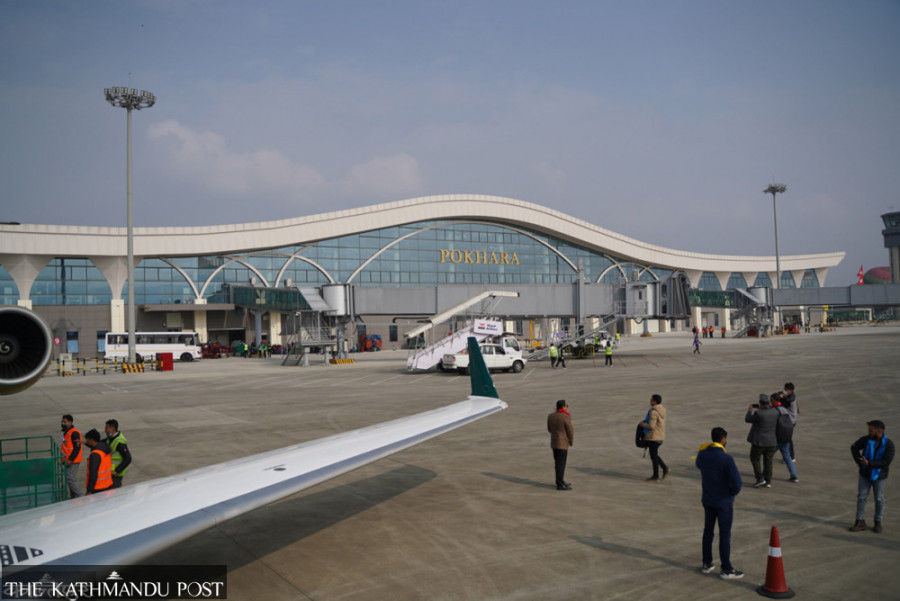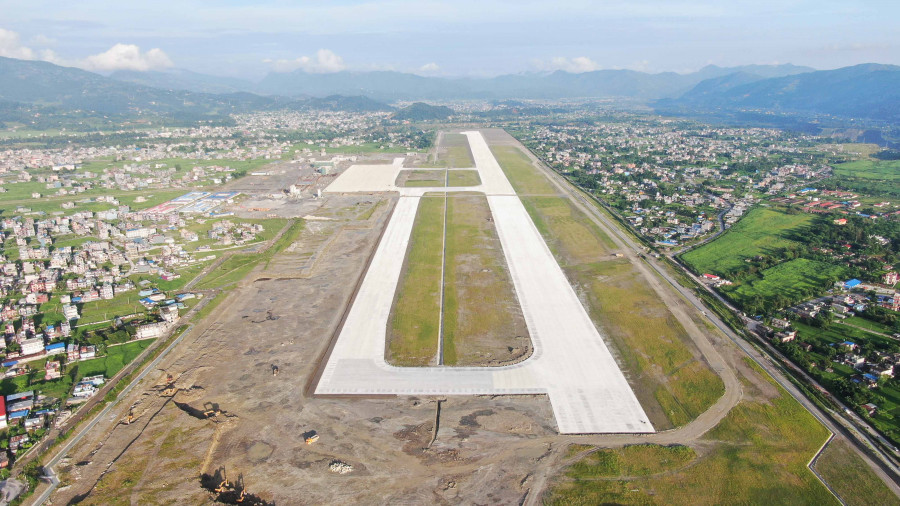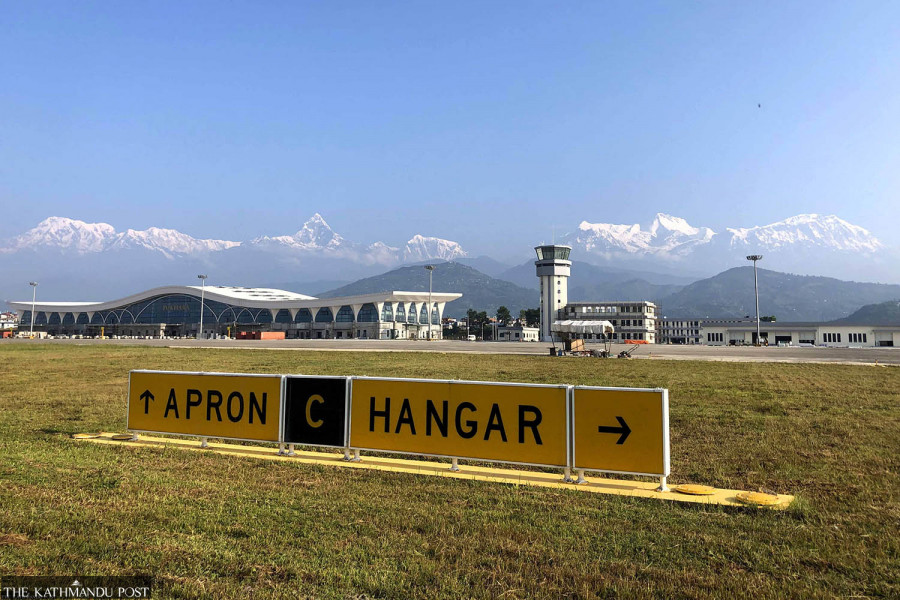A report shows narrow-body jets like Airbus A320 and A319 have payload issues due to obstacles near the airport.
The new airport would be best for cross-border flights to different Indian cities and Bangladesh, but there is already a geopolitical issue.
The buildup to the opening of Pokhara International Airport in the Himalayan foothills had got hopes way up.
Even the Chinese Embassy had joined in, tweeting on inauguration day on January 1, “Pokhara International Airport has been the dream of the people of Pokhara for 50 years. The airport is designed and built according to Chinese standards, which reflects the high quality of Chinese engineering, and symbolises the national honour of Nepal.”
China's enthusiasm is understandable; it was built with a Chinese loan. But it appears the expectations were too high, insiders say. Pokhara International Airport is intensely photogenic, but not much else. It could turn into a $215.96 million white elephant, they say.
A preliminary report shows that narrow-body jets like the Airbus A320 and A319 have payload issues due to obstacles near the airport, which is a 25-minute hop from Kathmandu.
Airports have load restrictions determined by obstacles, runway length, temperature, quality and other factors.
According to officials at the Civil Aviation Authority of Nepal and some pilots whom the Post talked to, the preliminary report has shown a payload penalty ranging from 5-10 tonnes, depending on the temperature and distance.
The permissible load for an A320 is 77 tonnes, but an A320 taking off from Pokhara will be allowed to carry a maximum load of only 68 tonnes, according to two pilots familiar with the preliminary report.
“This will prevent narrow-body jets from flying at full capacity at the new airport,” they told the Post.
The maximum permissible weight of a passenger on an international airline is 75 kg.
This means the A320, which has a seating capacity of 158, will have a payload penalty of five tonnes or 5,000 kg if the temperature is 25 degrees Celsius. If the temperature rises to 35 degrees Celsius, the payload penalty would go up to 10 tonnes or 10,000 kg.
However, the payload depends on the distance. According to the pilots who have analysed the report, airlines are not required to reduce the number of passengers if the flight time is below 1 hour and 20 minutes.
This means, there is no payload penalty for the flight to Lhasa, China from Pokhara or to New Delhi, India.
 The runway is 45 metres wide and 2,500 metres long and has an east-west orientation. Photo Courtesy: Civil Aviation Authority of Nepal
The runway is 45 metres wide and 2,500 metres long and has an east-west orientation. Photo Courtesy: Civil Aviation Authority of Nepal
For flights longer than 1 hour and 20 minutes, airlines will be able to sell less than 50 percent of the available seats.
“While taking off, we should consider that we are flying on a single engine, and the load is determined accordingly. So if there are obstacles, we need to reduce the load to climb,” according to a senior captain at Nepal Airlines.
“The plane should ensure a minimum climb gradient. This load should be reduced. Under certain circumstances, a 180-degree turn is the greatest life-saving manoeuvre at any airport. Pokhara, however, doesn’t allow that option.”
Pokhara International Airport has a one-way approach system for jet planes, like Kathmandu’s Tribhuvan International Airport. There is no possibility of expanding the airport as it sits in a narrow valley at an altitude of 800 metres above sea level.
The runway is 45 metres wide and 2,500 metres long and has an east-west orientation. It can handle only medium-range commercial aircraft such as the Airbus A320, Boeing 737 and Boeing 757.
The final report on the operating procedures for aircraft is yet to come.
According to an official at Nepal Airlines, who wished not to be named, load restriction means that airlines either incur a loss while flying to Pokhara or jack up the fares to compensate for 50 percent of the seats which have to be left empty.
“Reducing fuel is an option, but this is feasible only on short flights. On long-haul flights, you have to carry extra fuel.”
When flying to Pokhara, the pilot said, you need to carry contingency fuel in case of unforeseen circumstances such as changes in the weather, route changes due to air traffic constraints, holding and other reasons.
The new airport would be best for cross-border flights to different Indian cities and Bangladesh, but there is already a geopolitical issue.
The airport has also been examined in a broader geopolitical context.
The construction was bankrolled by China, and a day before the inauguration of the new airport, Beijing sent a clear message about its influence in Nepal, dragging the project into yet another geopolitical chessboard.
The Chinese Embassy wrote on its Twitter account, “[Pokhara airport] is the flagship project of the China-Nepal Belt and Road Initiative (BRI) cooperation.”
The Nepali government officials, to whom the Post talked, responded that the project had been envisaged before the BRI even existed.
On opening day, an Airbus A320 of Himalaya Airlines made a demonstration flight, arriving at 1:44 pm from Kathmandu.
The flight was conducted under visual flight rules (VFR), meaning the pilots flew the aircraft by making visual references to the ground and watching out for obstructions and other aircraft.
According to an official at the Civil Aviation Authority of Nepal familiar with the development, the director general forced Himalaya Airlines to conduct the flight.
 Pokhara International Airport is equipped with an instrument landing system, a system that allows pilots to approach the runway at night or in bad weather, but it will come into operation only after February 26.
Pokhara International Airport is equipped with an instrument landing system, a system that allows pilots to approach the runway at night or in bad weather, but it will come into operation only after February 26.
Pokhara International Airport is equipped with an instrument landing system, a system that allows pilots to approach the runway at night or in bad weather, but it will come into operation only after February 26.
“A test flight with the prime minister on board would have been a blunder, a crime. But Himalaya Airlines Vice-President Vijay Shrestha refused to fly the prime minister.”
Shrestha had to explain they were operating the flight under VFR, carrying only the crew.
This is not the first case. The civil aviation body, which currently wears two hats—as a regulator and a service provider—had flown dozens of journalists, government officials and other dignitaries on a test flight during the opening of Bhairahawa airport on May 16. It later described the flight as a “demo flight”.
The Post's attempts to contact the Civil Aviation Authority of Nepal Director General Pradip Adhikari were not immediately successful.
Another official at Himalaya Airlines, a Nepal-China joint venture, said that flying to Pokhara airport is not commercially viable.
Nepal is already an expensive destination for tourists due to its tax policies.
The fuel price is very high. In New Delhi, for international flights, jet fuel costs $999 per kilolitre, while in Kathmandu it costs $1,420 per kilolitre.
The civil aviation authority had recently increased the passenger service charge nearly fourfold for Indian tourists and threefold for other tourists.
Even the audit report of the Office of the Auditor General had pointed out that due to lack of “technical preparation for commercial operation of the new airport, it looks like Pokhara international airport will not come into operation immediately, even after the construction is completed.”
The report also said that the new facility would make the civil aviation body bear financial losses.
“While tourists are reluctant, airlines too hesitate to operate in Nepal,” according to an official at an international airline. “The new airport in Pokhara is definitely expensive. It could be another white elephant.”
The government took out a $215.96 million soft loan from China EXIM Bank in March 2016 to pay for the project, which was implemented on an engineering procurement and construction model.
Twenty-five percent of the Chinese loan is interest-free. The interest on the rest of the loan has been fixed at 2 percent per annum.
The loan repayment period is 20 years, including a grace period of seven years when no interest will be charged.
“The best way to make Pokhara airport financially feasible is to flatten some of the towering hills around it. But that’s impossible,” said a Nepal Airlines pilot.












